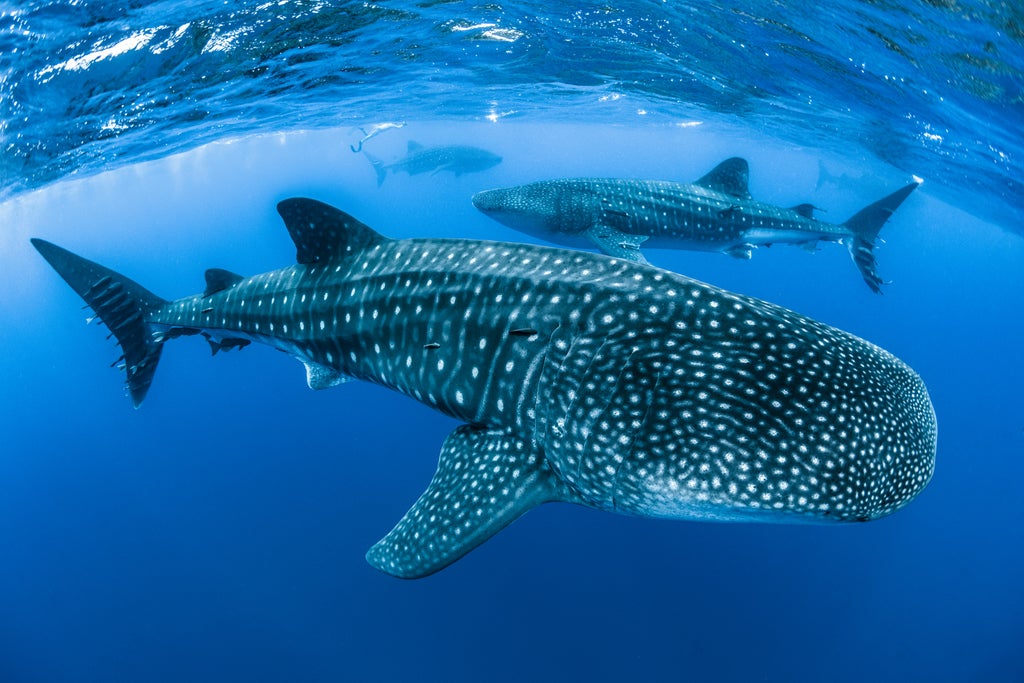Targeted measures could help protect endangered species with minimal impact on the shipping industry. Researchers have discovered that heavily used shipping lanes intersect crucial whale shark feeding grounds, posing a threat to this endangered species.
Research published today in Science of the Total Environment has identified areas where whale sharks are at the highest risk of colliding with large shipping vessels by mapping the locations of whale shark aggregations and overlaying them with information on shipping traffic.
“The almost ubiquitous overlap of at least some large shipping vessel traffic with whale shark aggregations underlines the magnitude of the threat the shipping industry poses,” says lead author Dr. Freya Womersley, a researcher at the Marine Research and Conservation Foundation (MARECO), the University of Southampton, and the Marine Biological Association (MBA).
“Our findings highlight the need for targeted measures within these areas to reduce the risk of collision and improve the conservation status of endangered whale sharks.”
A Growing Concern
The world’s merchant fleet has doubled in size in the last 16 years, now exceeding 100,000 ships transporting goods worldwide. This number is expected to grow by as much as 1,200 percent over the next ~27 years. Collisions with wildlife, known as ship strikes, are a growing concern and can be a leading cause of death for large marine animals, with more than 75 species at risk of population-level consequences. Whale sharks, which have a declining population, spend almost half their time in surface waters, often in coastal areas heavily used by shipping vessels.
Dr. Gonzalo Araujo, Director at MARECO, said: “Collisions with large ships are likely to be fatal for whale sharks, but evidence is scarce. That’s because whale sharks are slightly negatively buoyant, so their bodies sink. To inform conservation efforts, it’s important to quantify collision-related threats even when direct evidence is lacking.”
Identifying High-Risk Areas
Whale sharks, though mainly solitary creatures, regularly gather at special sites around the world called constellations to search for prey. Reducing threats within these high-density areas is crucial. Researchers from MARECO, the University of Southampton, the MBA, and the Marine Megafauna Foundation (MMF) collaborated with over 75 experts to map and gather insights on these constellations. They identified 107 areas in 26 countries based on observations of over 13,000 individual whale sharks.
The team used large ship position data from Global Fishing Watch to understand the density of shipping in these constellations. They found whale sharks were most at risk off the coasts of mainland Ecuador, Isla Mujeres and La Paz in Mexico, Ewing Bank in the northern Gulf of Mexico, Kota Kinabalu and Redang Island in Malaysia, Pintuyan in the Philippines, Musandam in Oman, and around the Seychelles and Taiwan.
They identified 39 sites where peaks in shipping activity coincided with peak seasonal occurrences of whale sharks. Dr. Chris Rohner, Principal Scientist at MMF, noted: “Many of these sites had more than one vessel per square kilometre in core habitats. For example, the constellation in Isla Mujeres in Mexico has an average of 56 ships passing through the core habitat monthly. These sites require urgent action to reduce the threats posed by shipping.”
Reducing the Risk
The research team simulated vessel movements within the whale shark constellation at Ewing Bank in the northern Gulf of Mexico to explore mitigation strategies. Reducing vessel speeds by 75 percent resulted in a small increase in total transit time of about 5 percent on average, but significantly increased whale shark safety, as slower ships can better avoid collisions.
Dr. Womersley said: “One of the benefits of speed reductions is that they can be temporarily introduced during whale shark peak seasons. These speed limits can also be applied to smaller vessels, which are less deadly but can still damage the sharks.”
Rerouting ships around core habitats had an even smaller impact, with only a 0.5 percent increase in total transit time (approximately 2.4 hours per vessel) and a 1.1 percent increase in total distance traveled on average. Dr. Araujo added: “Rerouting is the most direct way to reduce the risk of collision, and our results suggest that this will often be more cost-effective than speed reduction, mainly because whale shark core sites are small. Movements of as little as 12 nm (22.2 km) away from a core whale shark habitat could mean fast transiting ships avoid the site entirely.”
Amy Fraenkel, Executive Secretary of the Convention on the Conservation of Migratory Species of Wild Animals (CMS), noted: “CMS plays a pivotal role in securing the long-term survival of the whale shark — a globally endangered species. Ensuring the safety of this highly migratory species from vessel collisions within its migratory range, particularly at aggregation sites, is a key goal under CMS.”
The researchers emphasize that support for these measures requires increased awareness and education on the issue, as well as improved data. They suggest effective management strategies could pave the way for coexistence between this important species and the shipping industry.
The study, “Identifying priority sites for whale shark ship collision management globally,” is published in Science of the Total Environment and is available Open Access online. This study was partly funded by the German Federal Ministry of Environment, Nature Conservation, Nuclear Safety, and Consumer Protection, and Marine Research and Conservation Foundation, and was supported by the UK Natural Environment Research Council.
